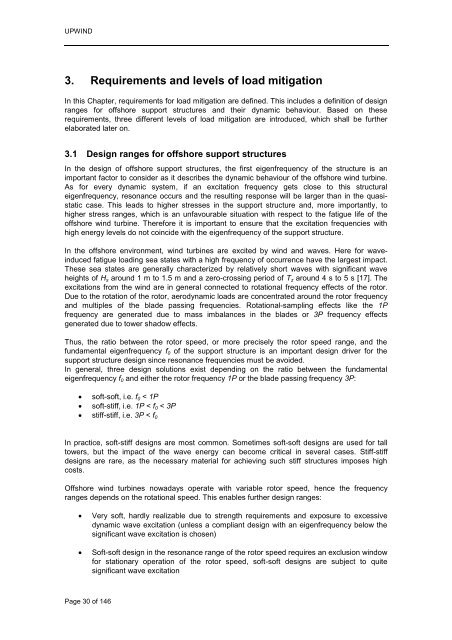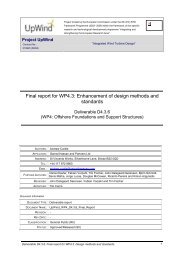You also want an ePaper? Increase the reach of your titles
YUMPU automatically turns print PDFs into web optimized ePapers that Google loves.
UPWIND<br />
3. Requirements and levels of load mitigation<br />
In this Chapter, requirements for load mitigation are defined. This includes a definition of design<br />
ranges for offshore support structures and their dynamic behaviour. Based on these<br />
requirements, three different levels of load mitigation are introduced, which shall be further<br />
elaborated later on.<br />
3.1 Design ranges for offshore support structures<br />
In the design of offshore support structures, the first eigenfrequency of the structure is an<br />
important factor to consider as it describes the dynamic behaviour of the offshore wind turbine.<br />
As for every dynamic system, if an excitation frequency gets close to this structural<br />
eigenfrequency, resonance occurs and the resulting response will be larger than in the quasistatic<br />
case. This leads to higher stresses in the support structure and, more importantly, to<br />
higher stress ranges, which is an unfavourable situation with respect to the fatigue life of the<br />
offshore wind turbine. Therefore it is important to ensure that the excitation frequencies with<br />
high energy levels do not coincide with the eigenfrequency of the support structure.<br />
In the offshore environment, wind turbines are excited by wind and waves. Here for waveinduced<br />
fatigue loading sea states with a high frequency of occurrence have the largest impact.<br />
These sea states are generally characterized by relatively short waves with significant wave<br />
heights of Hs around 1 m to 1.5 m and a zero-crossing period of Tz around 4 s to 5 s [17]. The<br />
excitations from the wind are in general connected to rotational frequency effects of the rotor.<br />
Due to the rotation of the rotor, aerodynamic loads are concentrated around the rotor frequency<br />
and multiples of the blade passing frequencies. Rotational-sampling effects like the 1P<br />
frequency are generated due to mass imbalances in the blades or 3P frequency effects<br />
generated due to tower shadow effects.<br />
Thus, the ratio between the rotor speed, or more precisely the rotor speed range, and the<br />
fundamental eigenfrequency f0 of the support structure is an important design driver for the<br />
support structure design since resonance frequencies must be avoided.<br />
In general, three design solutions exist depending on the ratio between the fundamental<br />
eigenfrequency f0 and either the rotor frequency 1P or the blade passing frequency 3P:<br />
� soft-soft, i.e. f0 < 1P<br />
� soft-stiff, i.e. 1P < f0 < 3P<br />
� stiff-stiff, i.e. 3P < f0<br />
In practice, soft-stiff designs are most common. Sometimes soft-soft designs are used for tall<br />
towers, but the impact of the wave energy can become critical in several cases. Stiff-stiff<br />
designs are rare, as the necessary material for achieving such stiff structures imposes high<br />
costs.<br />
Offshore wind turbines nowadays operate with variable rotor speed, hence the frequency<br />
ranges depends on the rotational speed. This enables further design ranges:<br />
� Very soft, hardly realizable due to strength requirements and exposure to excessive<br />
dynamic wave excitation (unless a compliant design with an eigenfrequency below the<br />
significant wave excitation is chosen)<br />
� Soft-soft design in the resonance range of the rotor speed requires an exclusion window<br />
for stationary operation of the rotor speed, soft-soft designs are subject to quite<br />
significant wave excitation<br />
Page 30 of 146











